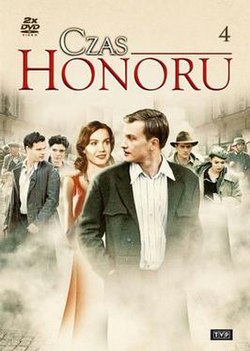You can help expand this article with text translated from the corresponding article in Polish. (December 2012)Click [show] for important translation instructions.
|
| Days of Honor | |
|---|---|
 | |
| Also known as | Time of Honor |
| Polish | Czas honoru |
| Genre | War |
| Created by | Jarosław Sokół Ewa Wencel |
| Written by | Jarosław Sokół Ewa Wencel Jerzy Matysiak |
| Directed by | Michał Kwieciński Michał Rosa Wojciech Wójcik Grzegorz Kuczeriszka Waldemar Krzystek Michał Rogalski |
| Starring | Jan Wieczorkowski Antoni Pawlicki Maciej Zakościelny Jakub Wesołowski |
| Composer | Bartosz Chajdecki |
| Country of origin | Poland |
| Original language | Polish |
| No. of series | 7 |
| No. of episodes | 90 |
| Production | |
| Producer | Magdalena Badura |
| Cinematography | Piotr Wojtowicz Grzegorz Kuczeriszka Paweł Flis |
| Running time | 50 minutes |
| Original release | |
| Network | TVP2 |
| Release | 7 September 2008 – 23 November 2014 |
Days of Honour (Polish : Czas honoru) is a Polish World War II television drama series, broadcast on TVP2 from 7 September 2008 to 23 November 2014, on STV Glasgow from 2 June 2014 and STV Edinburgh from 16 January 2015. [1] [2]